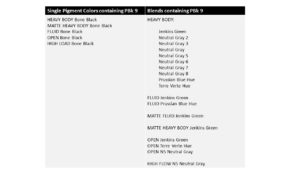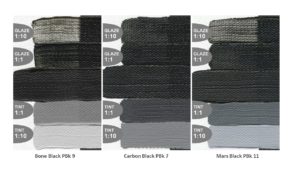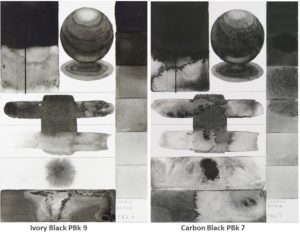Every now and then we get emails from artists inquiring whether our paints are vegan. We love that and are happy to share information so artists can feel comfortable using our products without compromising on their principles. To start the discussion on the same page, here is a definition of the term ‘vegan’ by The Vegan Society:
Veganism is a way of living which seeks to exclude, as far as is possible and practicable, all forms of exploitation of, and cruelty to, animals for food, clothing or any other purpose. (see: Vegan Society definition).
In the following, we hope to provide all the information as to which GOLDEN paints and products can be considered vegan. Instead of listing the hundreds of products that ARE free of animal products, we will point out which ones are not suitable for vegans.
In GOLDEN Acrylics
Our product range is by far the most extensive among the acrylics. Among the 300+ acrylic paints, gels, pastes, and mediums, only Bone Black and blends containing Bone Black are non-vegan. Bone Black (PBk 9) is made of carbonized cattle bones and as a single pigment color is produced in the Heavy Body, Fluid, and OPEN lines, as well as our Custom High Load Acrylics. See the table below for a list of all the acrylic colors that contain Bone Black:


Image 2: Bone Black, Carbon Black, and Mars Black in mass tone, tint and glaze.
Animal free alternatives to Bone Black would be Carbon Black (PBk 7) and Mars Black (PBk 11). However, neither Mars Black nor Carbon Black have the same warm hue as Bone Black. To create the same color space, mix Regular Gel Semi-gloss, Carbon Black and a small amount of Raw Umber to get a color that has a similar transparency, warm undertone and sheen to Bone Black. Also, one can always resort to the Virtual Paint Mixer for aid in color mixing, or simply some inspiration.
In Williamsburg Oil Colors
All of our Williamsburg Oil Colors contain small amounts of beeswax, which stabilizes the paint and prevents oil from separating and leaking out. Beeswax is a long proven stabilizer for oil paints and part of the tradition of Williamsburg Handmade Oil Paints. Other, animal-free stabilizers exist, but they have their own issues, which would require more research before we would venture to try or use them. For example, metal stearates, and in particular aluminum stearate, is widely used and is very effective at making the oil form a gel, which keeps pigments in suspension. However, in conservation research it is often thought to be a major cause of free fatty acid crystallization, which shows up as an efflorescence or whitish surface bloom. These additives can also change the consistency of the paints in a dominant way, making them more homogeneous across a paint line. This can be a desired quality for some painters, but it is the individuality of each color in consistency, grind, and feel, that makes Williamsburg Oil Colors what they are.

While beeswax is by definition a non-vegan product (Vegan Society: Honey Industry), if one was willing to look past that, then only three of the 173 colors contain animal ingredients. These are Ivory Black (PBk 9), which is no longer made from ivory but rather cattle bones, as well as the two blends made with this pigment: Payne’s Grey and Cold Black.
Ivory Black, like the earlier Bone Black, is a jet black color in mass tone, uniquely warm in undertone, and mixes to warm gray tints. Its tints can be mimicked with Mars Black, while Lamp Black and German Earth somewhat resemble its masstone.
Beyond our oil colors, Rabbit Skin Glue is a product that many traditional oil painters are familiar with. It is a size, valued for the drum tight tension it creates on cotton and linen canvases. As the name suggests, it is made of refined rabbit collagen. Alternative animal-free sizes exist of course, but so far we know of none that replicates the tightening of canvas to the level that Rabbit Skin Glue does. Our GAC 400, an acrylic fabric stiffener, would be the closest match. See Just Paint article GAC 400: Fabric and Paper Stiffener for detailed usage instructions.
In QoR Watercolors
The same Ivory Black (PBk 9) discussed earlier is the only non-vegan color produced in our QoR Watercolor line. It is a granulating, staining, and opaque warm color. The alternative, Carbon Black (Pbk 7), is significantly cooler and not granulating. However, Carbon Black can be used together with Raw Umber or Burnt Umber, to mix a color similar to Ivory Black. Other colors that could be used for mixing warm blacks together with Carbon Black would be Van Dyke Brown and Payne’s Gray, Neutral Tint, and Sepia.

QoR Watercolors do not contain any honey, which is used in a few traditional watercolor paints as plasticizer. QoR Ox Gall, too, is completely vegan friendly as it is a synthetic material and involves no animal parts.
Animal Testing
With the topic of animal testing we enter what seems like a gray zone in regard to veganism. Fact is, Golden Artist Colors does not carry out any animal testing. However, many of the ingredients used for our paints have been tested on animals. This is unavoidable under current laws. Regulations, particularly those decreed by the REACH (Registration, Evaluation, Authorization and Restriction of Chemicals), require that the potential toxicity of chemical substances be determined in order to help safeguard human and environmental health. REACH aims to control and limit animal testing to a minimum, by having companies that produce or import the same substance, work together and share toxicity information. More information on animal testing can be found here:
Golden Statement on Animal Ingredients and Animal Testing
European Commission: REACH and Animal Testing
European Chemicals Agency: Animal Testing Under REACH
Beyond GOLDEN
If wanting to go completely vegan in the studio, a couple of other art materials would have to be avoided. A big one would be natural hair brushes. Especially oil and watercolor artists would feel the difference, since synthetic hairs miss the curved form of hogs hair, for instance, which allows brushes to have defined tips. The surface texture of natural hairs furthermore allows more paint to be carried by a brush. The ammonia in wet acrylic products damages natural hair brushes, and therefore acrylic painters are anyway better off with synthetic hair brushes. Another item that can contain animal products are watercolor papers. The surface sizing of some watercolor papers is still done with animal hide glues. Specific information can usually be obtained from the paper manufacturers’ websites.
Always feel free to reach out to the Materials and Application Team with any questions you might have. Find us here.
About Mirjam Auf der Mauer
View all posts by Mirjam Auf der Mauer -->Subscribe
Subscribe to the newsletter today!
No related Post

NICE EXPLANATION !!
VeRY INTERESTING !!!
Thank you for this information. As a vegetarian it is extremely important to me to know just what the paints I use consist of with regards to animal products. Your initiative to provide this information is appreciated.
Yes it is very useful to know hich ones use animal substances. Although I am mostly vegan I don’t have a problem with honey if its not mass produced or does harm to the bees. I’m concerned with animal testing though and despite manufacturers maybe not wanting to test on animals and maybe not doing so in the finshed product like, I understand, Golden and Gamblin it seems that REACH has forecd ingredients to be tested on animals sometimes? Yet as many of these ingredients have been used for decades and now it is much more reliable to use other means, after all not all which is toxic to animals is toxic to humans, they do this? People should be given direction on how to use paint safely , don’t eat or drink when using it and keep away from children and pets, wash out containers and so on. Not poison more animals unnecessarily and without due cause
As a vegan artist, I really appreciate this information!
Thank you so much for this useful information.
Thank you so much for your info…while I am not vegan, I am a vegetarian who tries to avoid all unnecessary harm to our planet and those who share it!
I am neither a vegan nor a vegetarian, though when I do use animal products, I try to ensure that the product was produced humanely. I respect that some people have made a commitment beyond that, and are taking the time to ask questions about the products they use. Like Roberta, I am glad that JustPaint is taking the time to clearly explain which paints use animal products and why, and also explain what products that don’t include animal products might be substituted. I certainly did not get the impression you were trying to influence anyone’s decisions, including mine. You provided information so that people who choose to not use animal products have the information they need to make an informed decision. I admire you for that. And I learned a few things along the way. Thanks. Some of my artist friends are vegan; I’ll point them to your article.
I wish paint manufacturers would tell us if products are vegetarian as I use honey but don’t want animal products 🙂 Also no real fur as it can be trapped or come from fur farms and there are great substitutes without it
.Thanks very much for this excellent information.
How old is the use of beeswax in oil paints?
How does beeswax perform in heatwaves?
Aside from beeswax, what other additives, extenders, fillers, wetting agents etc can be in Williamsburg oil paints (and not on the label) aside from oil and pigment? I’m glad to hear there’s no Alim stearate etc as Williamsburg is my chosen brand
Hello Bob,
Thank you for your comment and please excuse this late response. Williamsburg Oil paints consist of pigment and alkali refined linseed oil with small additions of calcium carbonate and/or barium sulfate to modify feel where needed and a very small amount of beeswax to stabilize the oil. The paints with slower drying pigments contain also a small amount of driers.
We have not specifically tested the impact of wax mediums on the stability of oil paint films in hot climates, which might be a valid concern. We generally don’t recommend adding more than 20 or 25% wax medium to oil paints. Beeswax melts at temperatures around 63°C-68°C/ 145°F – 154°F, so it seems unlikely that it would ‘run down a painting’, especially if the painting has already cured.
The use of oil modifying mediums such as wax or wax-resin mixtures were already in vogue in the late 18th century. Joshua Reynolds, for instance, experimented with wax (see https://www.nationalgallery.org.uk/media/23860/volume35essay2reynoldstech.pdf).
As a note for your future tests a generally very well respected rival paint maker* uses a Semi-hydrogenated oil as a stabilizer. Sometimes identified in tests as hydrogenated caster oil or caster wax, it was claimed many years back by the makers as a hydrogenated ‘linseed butter’ on a popular artist forum. (Thus they can rather cheekily claim to be nothing but oil and pigment.) It seemed to perform better in water sensitivity cleaning tests than two other popular brands (It feels poor form to name names on another makers site.)
*I do have some issues with them adding undeclared on their tube quantities of zinc white to their titanium white and a smidge of titanium white to their zinc white. What else are they toning? I feel a break of trust.
I absolutely appreciate this information being put it there for easy access to all.
I know I am one if those people who have reached out in the past to GOLDEN inquiring about which products I should about as a vegan, and I love that this is now on your site for easy reference!
I do have a question for you all. I am completely obsessed with the color Prussian Blue Hue as it seemed to work as a great replacement for another color of yours I loved but has been discontinued (I think it was called Denim blue or something like that).
Can you share a possible combination of others colors I might use to create a similar color to Prussian Blue Hue? Many thanks!!! This past demonstrates another reason why GOLDEN is my go to brand – the integrity of the company and high quality of products are unmatched!!!
Hello Devin,
Thank you for your comment and positive feedback! That’s much appreciated. If you wanted to mix your own Prussian Blue Hue, you could simply substitute the Bone Black with Carbon Black and add only a little of that (1 part) to some Dioxaxine Purple (3 parts) and a good amount of Phthalo Blue RS (15 parts). Alternatively, you could try a 1:1 mixture of Quinacrodone Crimson and Phthalo Blue RS. Feel free to try the online mixer: https://www.goldenpaints.com/mixer. When trying to match dark colors like Prussian Blue Hue, it helps to also look at the tints on the very right. More on the color mixer can be found here: https://justpaint.org/re-introducing-the-virtual-paint-mixer/
I really enjoy glazing with bone black and transparent brown oxide. Delightful color. I’d like to see you add some more animal based colours, mummy brown perhaps.
I have some of your paints and absolutely love them.
But I’m wondering, if you can use other combinations to create a vegan equivalent to bone black, why don’t you make it and sell it, instead of using animal products?
Thank you for your question, and for using our paints. There are artists who depend upon Bone Black when creating their paintings, so we continue to provide this paint.